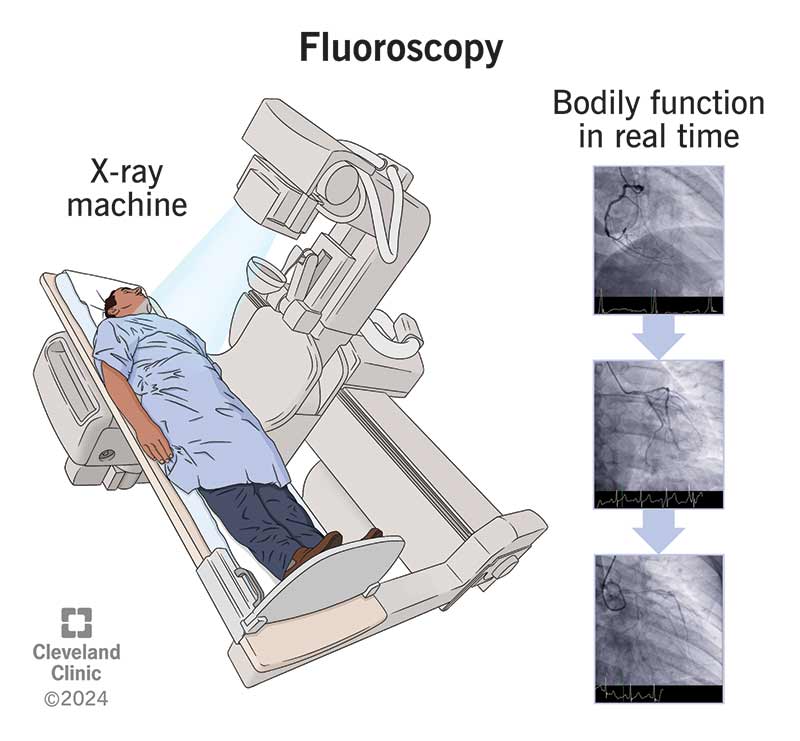Fluoroscopy is a form of medical imaging that uses a series of X-rays to show the inside of your body in real time, like a video. Healthcare providers use it to diagnose conditions and to help guide medical procedures. Common examples of fluoroscopy include angiography, barium swallow, cardiac catheterization and stent or catheter placement.
Advertisement
Cleveland Clinic is a non-profit academic medical center. Advertising on our site helps support our mission. We do not endorse non-Cleveland Clinic products or services. Policy

Fluoroscopy is a medical imaging procedure that uses X-rays to show internal organs and tissues working in real time. Providers use fluoroscopy to diagnose issues with your organs or help guide them while performing medical procedures.
Advertisement
Cleveland Clinic is a non-profit academic medical center. Advertising on our site helps support our mission. We do not endorse non-Cleveland Clinic products or services. Policy
Compared to plain X-rays, which get a snapshot of a part of your body, fluoroscopy gets images of what your body’s doing as it happens. Think of it like the difference between a still photograph of a moment in time versus recording an event so you can see how it unfolds.
Healthcare providers use fluoroscopy to help diagnose issues with specific body parts. They can also use it to help them guide procedures (like placing medical devices) inside your body or during injection or aspiration (known as interventional guidance).
Healthcare providers can use fluoroscopy to diagnose conditions in many parts of your body. Some examples include:
Advertisement
Providers can use fluoroscopy during procedures to help them guide surgical instruments or medical devices. Examples include:
Fluoroscopy works by using a special camera that uses pulses (brief bursts) of X-ray beams to take pictures of your insides. This can be while your organs perform their normal tasks or while your provider performs a procedure.
Some procedures use a contrast agent to help the provider see your organs and structures better. You might hear it called a dye, but it isn’t the type of dye that can stain your clothes. Your provider might:
Your preparation will depend on the type of fluoroscopy procedure and why you’re getting it. Some procedures don’t require any special preparations. For others, your provider may have you avoid certain medications and/or fast (not eat or drink anything) for several hours before the procedure. Ask your provider if you have questions about what you need to do before the procedure.
Let your provider know:
Depending on the type of procedure, you may have your fluoroscopy at an outpatient center or as part of your stay in a hospital. Right before the procedure, you may need to remove jewelry or change into a gown.
Your fluoroscopy may include the following steps:
Advertisement
Depending on the test, you might be awake or sedated (under anesthesia) for a fluoroscopic procedure. For instance, you’re more likely to be sedated if your provider is using it as imaging guidance during surgery or stent placement.
Other fluoroscopy tests are mostly painless and might require you to be awake during the procedure so that you can follow your provider’s instructions. Your provider will let you know if you’ll have anesthesia for your procedure or not.
The main risk of fluoroscopy is radiation exposure. Fluoroscopy for diagnostic purposes uses very low levels of radiation. When providers use fluoroscopy during a surgery, you’re exposed to radiation for a longer period of time, which could:
The likelihood of experiencing these side effects is very small. If the procedure is medically necessary, the benefit outweighs the possible radiation risks.
If contrast dye is part of your fluoroscopy procedure, there’s also a small risk of an allergic reaction. Be sure to tell your provider if you have any allergies or if you’ve ever had a reaction to contrast material.
Advertisement
The main benefit of fluoroscopy is that providers can see how your organs are working or where structures are while they perform a procedure. It’s unlike many other forms of medical imaging (like a CT scan) where you can only see one moment in time.
The kind of results you get from a fluoroscopy test will depend on the kind of test you had. If the results show that a part of your body isn’t working as it should, you may need additional diagnostic tests or treatment. Ask your provider what you can expect.
Depending on the type of fluoroscopy test you’re having and whether or not it’s part of a surgical procedure, you might know the results of the test:
Ask your provider when you can expect to know the results.
Contact your healthcare provider if you have any questions about how to prepare for the test or what the results mean.
Fluoroscopy imaging itself is painless and noninvasive. But if your healthcare provider is using fluoroscopy as imaging guidance during a procedure like surgery or intervention, you may experience pain due to the procedure, not the fluoroscopy. Your provider will let you know what kind of pain levels you can expect during and after your procedure.
Advertisement
If you’ve ever taken your car to a mechanic, you know that they often can’t know what the issue is just by looking at a picture of your vehicle. They might have to watch it run and understand what’s happening as the car works. Fluoroscopy is a similar idea: Your provider needs to see your body working in order to know where the issue is and how to treat it. They can also use it to accurately place medical devices. Don’t hesitate to ask your provider about how the test works or what the results mean.
When you need a clear picture of what’s happening inside your body, the Cleveland Clinic imaging team is here for you.

Last reviewed on 04/11/2025.
Learn more about the Health Library and our editorial process.